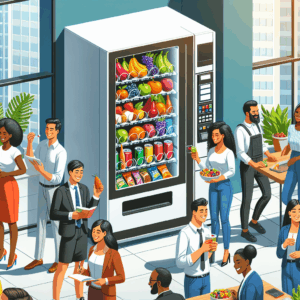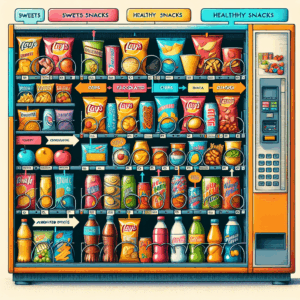Advanced Inventory Management
Real-Time Stock Monitoring
One of the coolest things about modern vending machines is their ability to keep track of stock in real-time. That’s right, they know exactly what’s in there without you having to go on a wild treasure hunt to check. This is a game-changer for anyone managing multiple machines across different locations.
Imagine being able to log into a system and see exactly how many snacks and drinks are left in each machine. This means you can plan refills more efficiently, sending stock only when it’s needed. To me, it’s like having a little assistant that knows your every move and keeps you one step ahead.
With this tech, you’re not just saving time, you’re also ensuring customer satisfaction. No more disappointed customers staring at an empty row longing for their favorite treat. It’s a win-win in my book.
Automated Reordering Processes
Gone are the days of jotting down inventory needs on scraps of paper. With automated reordering, the system does the heavy lifting for you. Based on the real-time stock levels, it can even trigger automatic orders to refill products before they run out.
You see, it’s not just about having stuff; it’s about having the right stuff at the right time. Lean inventory is all about efficiency and keeping costs down, and automated reordering gets you there effortlessly. Plus, it frees up your mind for more creative tasks – like picking out what’s new and hip to stock next.
This kind of efficiency isn’t just impressive on paper; it translates directly to better service and ultimately to happier customers. And who doesn’t want that?
Data Analytics and Reporting
Collecting data is one thing, but turning that data into actionable insights is the true power of modern vending machines. By analyzing sales trends, you can understand peak purchasing times or identify the slow movers in your machines.
This analytics prowess helps you tailor your offerings to exactly what people want. Perhaps those kale chips aren’t doing well, but peanut butter cups fly off the shelves. You’ll not only know this but can adjust the stock to maximize profitability.
It’s all about making informed decisions that help you run a tighter ship. And trust me, understanding your consumer behavior is like having the secret sauce in your business strategy.
User-Friendly Interface
Intuitive Touchscreen Display
The modern vending machine is often equipped with a touchscreen that is not only easy to use but incredibly intuitive. This innovation kind of feels like using a smartphone, which everyone’s pretty accustomed to nowadays.
What this means for you is that anyone can walk up, swipe through options, and make their selection without feeling like they’re trying to solve a puzzle. This ease of use is key to keeping customers happy and sales flowing smoothly.
An intuitive interface also cuts down on the time it takes for people to make purchases, reducing lines during busy periods. It’s just a better experience all around, and frankly, I think it makes vending feel a bit posh.
Multilingual Support
Today, vending machines equipped with multilingual support make it incredibly easy for people who speak different languages to make purchases. You don’t need a translation app because the machine does the talking for you.
I find this feature particularly useful in big cities or international transit areas where a range of languages is spoken. It truly makes the machine more accessible to everyone and enhances customer inclusivity.
It’s all these touches that might seem small but significantly widen your customer base, making people feel welcome and understood. And isn’t that what good service is all about?
Accessible Design Features
A vending machine shouldn’t just be smart; it should be accessible to everyone. This might sound obvious, but having design features that cater to people with disabilities is essential in today’s age.
From the height of the touchscreen to the placement of the product slots, everything should be within easy reach. Some modern machines even have voice-activated commands and braille labels, helping to guide users who need additional assistance.
To me, creating an inclusive design shows genuine care for all your customers. It’s about breaking down barriers and making sure everyone has the same seamless experience, which I believe should always be in focus.
Energy Efficiency
LED Lighting
Energy-saving features, like LED lighting, are where it’s at for vending machines striving for energy efficiency. If you’re like me and care about saving the planet and a few bucks, LED lights are a no-brainer.
These lights not only last longer than traditional bulbs but also consume significantly less power. They provide bright and even lighting without burning through electricity, keeping your energy bills down.
You see, it’s about investing a little upfront for substantial savings over time, which is smart business 101. And besides, the machines look sleek and modern with LEDs, which is just the cherry on top.
Low-Power Cooling Systems
Nobody wants a warm soda from the vending machine, but keeping those drinks cool shouldn’t come at the expense of sky-high energy bills. That’s where low-power cooling systems come in.
These systems are designed to maintain optimal temperatures while using minimal power. They run more efficiently and quietly, making them perfect for environments where both energy use and noise level matter.
Trust me, when you adopt these energy-efficient technologies, you’re not just saving on costs – you’re also taking a statement stand for sustainable vending. And that’s a message that resonates well with today’s consumers.
Programmable Energy-Saving Mode
Many of the more advanced machines allow you to program energy-saving modes during non-peak hours. This is the kind of feature that makes you feel like you control the vending matrix.
I mean, think about it. During the wee hours of the night or office hours when foot traffic is lower, the machine hibernates, using minimal energy until the rush picks up again. It’s all automated, so there’s nothing for you to fiddle with constantly.
Ultimately, this translates to more savings for you and a lighter carbon footprint. It’s about working smarter, not harder, and isn’t that the ultimate goal?
Versatile Payment Options
Contactless Payment Systems
In this digital age, fishing out quarters from your pocket feels like a relic of the past. That’s why contactless payment systems in vending machines are all the rage right now.
With the simple tap of a card or a swipe of a smartphone, customers can easily make their purchase. To me, it’s all about matching the pace of our fast-moving society where convenience is key.
When your machines support these advanced payment options, not only do you make buying easier, but you also capture sales from those who might otherwise pass up a purchase because they didn’t have cash on hand. It’s all about meeting consumer needs head-on.
Mobile Wallet Integration
I can’t stress enough how vital mobile wallet integration has become. With apps like Apple Pay, Google Wallet, and Samsung Pay ruling the roost, having your vending machine equipped to handle these services is crucial.
I find it’s always a plus to tap my phone rather than searching for exact change. It’s seamless, easy, and part of what makes life in this digital age so convenient. Plus, it appeals to the tech-savvy crowd who are all about quick, efficient transactions.
Customers appreciate this kind of forward-thinking approach and, in turn, are more likely to become repeat buyers. It’s a literally cashless society, and staying ahead in this trend is just good business sense.
Compatibility with Credit and Debit Cards
Incorporating traditional card payment options remains an absolute necessity despite the rise in digital wallets. People still trust and rely on their plastic, so it’s wise to offer these payment methods.
Having this compatibility means you’re catering to a broader audience, from the tech lovers to the traditionalists who prefer good old cards. It’s all about rounding out your payment options to make sure no sale is left on the table.
And from my experience, embracing these payment systems helps to increase sales, providing customers with the payment methods they’re most comfortable with. You should have a well-rounded payment strategy to maximize sales potential.
FAQ
What makes inventory management systems crucial for vending machines?
Inventory management systems ensure that stock levels are optimized, reducing downtime and improving customer satisfaction. They streamline operations by automating the reordering process and providing real-time insights into product demand.
How can energy-efficient features benefit vending machine operators?
Energy-efficient features, like LED lighting and low-power cooling systems, lower operational costs by reducing electricity consumption. Programmable energy-saving modes further cut expenses by minimizing power usage during off-peak times.
Why are versatile payment options necessary for modern vending machines?
Versatile payment options cater to diverse consumer preferences, allowing for convenient transactions. As digital payments become more prevalent, supporting methods like contactless cards, mobile wallets, and regular credit/debit cards increases accessibility and sales.
How do accessible design features enhance the user experience?
Accessible design features make vending machines usable for everyone, including those with disabilities. Elements like appropriately placed controls, braille labels, and voice commands ensure inclusivity, improving the overall user experience.



